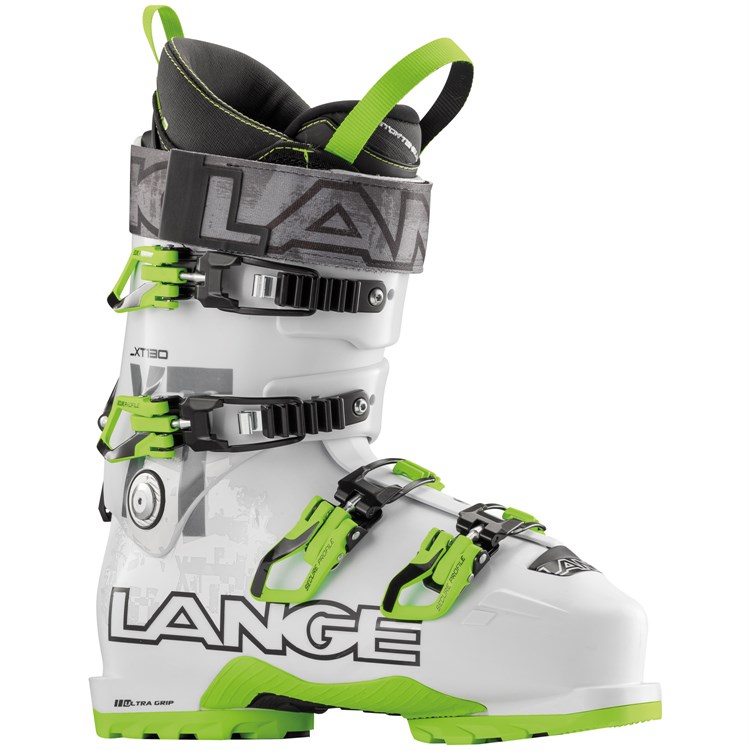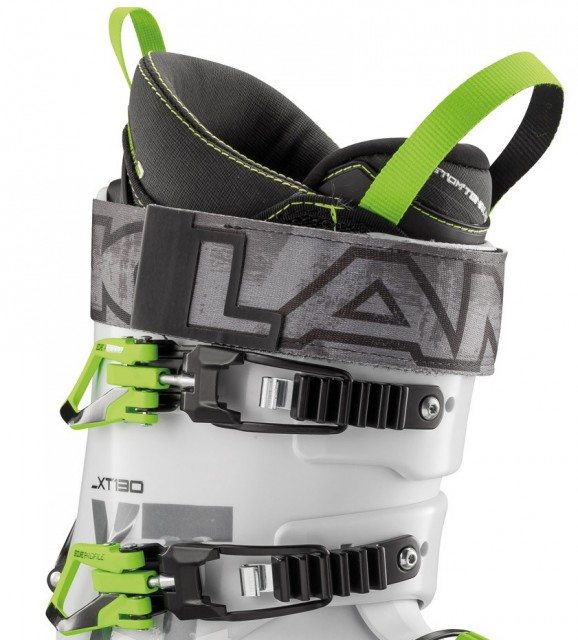
Lange XT 130 LV
Available Sizes: 22.5 – 29.5
Size Tested: 27.5
Stated BSL (27.5): 316mm
Stated Flex: 130
Stated Last: 97mm
Blister’s Measured Weight:
- shells, no liners: 1632 & 1630 grams
- stock liners + laces, no footbeds: 446 & 454 grams
- shells + stock liners: 2084 & 2084 grams
MSRP: $700
Test Locations: Alyeska Resort, AK; Craigieburn Ski Valley, Porter’s Ski Field, New Zealand
Skis Used: Blizzard Bodacious, 185 cm (15/16); Blizzard Cochise, 185 cm (15/16); 4frnt Devastator, 194 cm; DPS Wailer 105 T2 Hybrid, 185 cm; Salomon Enduro XT 850, 184 cm; Volkl Shiro, 193 cm
Days Tested: 12
Intro
Lange says of the new XT 130 LV:
“The all-new, redesigned XT 130 LV is the ultimate high-performance freeride boot with ski/hike versatility for hard-charging experts. Featuring a new 97mm fit and lightweight shell construction, the new XT delivers first-of-its-kind versatility without sacrificing an ounce of Lange’s legendary precision and downhill performance. The next-generation Ski/Hike System 2.0 with patented Power V-Lock technology features a new metal-on-metal locking mechanism for powerful, real-deal downhill performance. Combined with a wider V-Lock for increased hiking range-of-motion and maximum mobility in “hike mode”, WTR rocker sole compatibility, and lightweight shell and liner engineering, the XT 130 LV sets a new standard in hike-able ski boot performance.”
We took the Lange XT 130 LV down to New Zealand last August, where we hoped that they would prove to be a good choice for the Canterbury club fields, where steep terrain and all kinds of snow conditions are often accessed by short hikes or even ridge scrambles. Alpine boots with a walk mode are a great fit for these conditions (see our AT Boots & Bindings 101 article for a discussion on the various types of “walk mode” boots), and the XT 130 LV proved to a be a solid companion throughout the trip. More recently, it has continued to be a great choice for all-around mechanized skiing back home in Alaska.
Fit
Our usual caveat on bootfitting is that any boot buying decision should be done in conjunction with the your most trusted local bootfitter. My second caveat is that I haven’t spent much time in Lange boots in recent years, so I don’t have a lot of comparisons in that realm.
I did try on the 14/15 version of the XT 130 LV, and while the 15/16 XT 130 LV features a new lower (new shoe or clog), the fit did not (to me, at least) seem to have significantly changed based on a brief shell fit and then putting the same liner in each boot.
I should mention that Lange recommended that I go with the LV version of the XT 130 instead of the MV (despite my concerns about my high arches/instep) because they felt that the heel and ankle would provide higher performance and snugger heel and ankle fit.
As expected, the ankle and heel did feel a bit lower volume to me that the two alpine boots I’ve used most recently which are the Salomon X-Max 130 and the Tecnica Cochise Pro 130. The heel pocket provides the best hold I’ve had of any of these three boots, and is as good as I’ve ever had. I have spent most of my time in the XT 130 using a ZipFit liner that was molded for this boot, but I have used the stock liner as well and it has close to as good of heel hold. I have also swapped the same ZipFit into my Cochise Pro 130 to compare and still feel that the XT 130 LV shell is the best of the bunch in terms of heel hold.

The instep height of the XT 130 LV is lower than the Cochise Pro 130 or the X-Max 130. Because of my relatively high insteps, I used thinner insoles in these than usual, and recently had Corey Anderson at Powderhound in Girdwood, AK grind the removable zeppa about 1-2mm, which has also provided a bit more room.
I typically maximize the amount of outward movement when adjusting cuff alignment, and I did this with the XT 130 LV as well. It seems to have a little more outward rotation (accommodating Varus leg shapes) than the Cochise Pro 130.
Lengthwise, the XT 130 LV shell feels just about middle of the road when compared to the other size 27.5 shells I’ve used over the last few years. In particular, it is at least a few mm shorter than the Cochise shell which is also reflected in it being about 5 mm shorter in BSL per shell size.
I have not yet done any punches in the toe area of the XT 130 LV, but I feel that it’s not quite as roomy as the Salomon X-Max 130 or the Cochise Pro 130. But it still has enough room that I can ski all day without feeling like my little toe is getting squashed. I may add a 6th toe punch because it does feel a little tight when walking around especially with the buckles loose and will likely make the boot a better candidate for long days in my boots while guiding this season.
Buckles and Powerstrap
The buckles work great and seem to have a little smoother action and better mechanical advantage than those on my Cochise Pro 130. I have had no issues being able to adjust them to my preference.

The powerstrap is about 2” wide and closes with the velcro closure. Once it loosens up a little it’s essentially useless, and I’ll likely replace with a Booster strap as I often do to provide a little more leverage, elasticity, and forgiveness.
Sole Blocks
The XT 130 LV comes with 2 sets of sole pads: one set of more rockered, WTR-compatible soles, and another that is ISO 5350 compatible with essentially any alpine binding. The part of the sole that is removable is just the pad on the bottom (see the above pic), so that the primary part of the boot sole that contacts the binding is molded into the same piece of plastic as the lower shell. In theory this may provide a more solid interface than the completely removable sole blocks on boots like the Cochise Pro 130.
So far I’ve only used the alpine style ISO 5350 sole blocks, and have used them with Marker Jesters, Marker Jester demo bindings, and Salomon STH2’s without any trouble. I’m not sure what situations would prompt me to use the WTR soles, but maybe if was hiking a lot on rock or other hard surfaces, I’d see enough benefit in the more rockered soles to justify the decreased binding compatibility.
NEXT: Walk Mode, Downhill Performance, Etc.

Thanks so much for this great review. I was wondering if you could do a bit more of an A/B on this XT 130 LV vs. the MTN Lab, especially in terms of (1) fit, (2) downhill performance, and (3) uphill walking performance.
I currently have the 130 Cochise Pro, which I purchased several years ago because at the time I think it had the best downhill performance of the AT boots on the market. But, because I have a very low volume foot, I’ve had constant issues trying to get the fit of these boots right. I likely will be buying a new boot, and downhill performance is very important to me. I use these AT boots as my 1 boot quiver, for both resort and backcountry. With my low volume foot, it seems like the MTN Lab and the XT 130 LV are the two best bets on the market. I would love to get your thoughts on these two side by side.
Thanks so much.
Can you elaborate on Lange’s recommendation of LV over MV for you.
My feet fit nicely in my regular width RX130 but I struggle with chicken ankles and lower calf.
Wondering if LV is smaller through the lower portion of upper cuff or is it just the lower clog thats different?
Paul,
Great in-depth review!
I currently ski RX 130 LV 27.5 and think the XT is going to be my next boot.
I’m very interested in getting Zipfit liners and wondering if you could provide me with the specific model of Zipfits that worked well in these boots?
Thanks
A bit off-topic maybe but do you know a difference between the 15/16 RX (white/green) and the 16/17 (all grey)?
I think that should be my next boot and the whit/green ones are not really more beautiful but costs 200€ less.
What would you prefer?
Thanks a lot,
Franz
Hey guys, I’m tempted to buy the 130 XT in combination with a real touring boot. I spend about half of my time out of bounds, other half inbounds with the family, and I do the occasional 1-2 day ski tour. I have been skiing Lange and Head boots with 120/130 flex and would be nervous that the XT would feel like a foul compromise between the alpine and touring boots. So what to do, an XT in combination with a real touring boot or a classic alpine boot in combination with a real touring boot?
Or the XT as a one quiver boot? Thanks for your views!